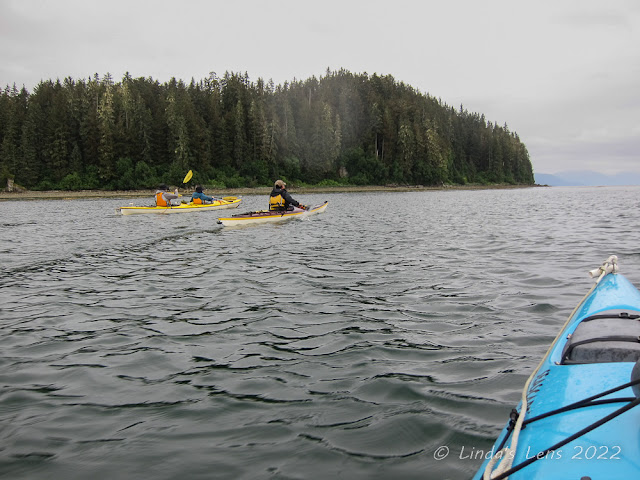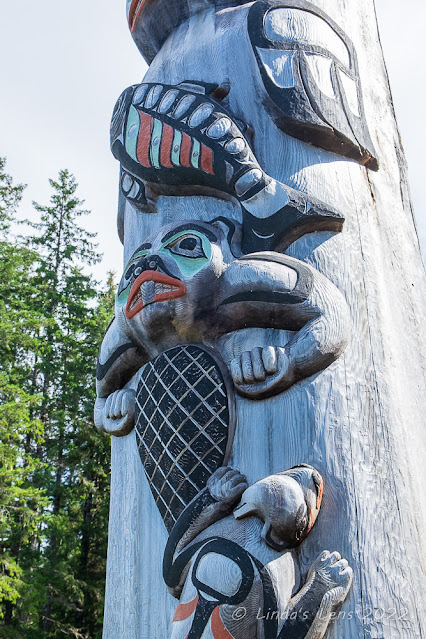(This is seventh in a series of posts recapping my recent trip to Glacier Bay National Park in southeast Alaska.)
As mentioned in my previous post on the last day of our vacation to Gustavus, Alaska my hubby and I had nearly an entire day to fill. Our flight home didn't leave Gustavus until 5:30 pm. So we slept in and enjoyed a leisurely breakfast while discussing how to spend our time.
 |
| Hiking the Forest Trail in Glacier Bay NP |
The weather, which had been surprisingly cooperative the entire visit, decided to throw us a curve ball on the final day. We woke up to foggy skies and misty rain. However, we didn't want to spend nearly an entire day just sitting around our place of lodging, so we asked one of the drivers to take us back to Glacier Bay National Park.
 |
| This large mushroom was catching raindrops |
Yeah, the weather was soggy but we had raingear! And we're from the Pacific NW, so rain is not a new thing to us. Hubby and I decided to explore one the short trails near the National Park Lodge. Although I'd done a bit of sightseeing here two days ago, this would be his first time seeing the area.
 |
| The ultra-mossy forest floor |
We decided to hike the nearby Forest Trail. From the National Park Lodge, the Forest Trail was a 1-mile stroll through lush, moss-carpeted woods. Apparently this forest grew on top of a past glacial moraine.
 |
| Lots of lily pads in this pond |
The forest here reminded us both of the coastal forests back home in Oregon. Lots of moss, ferns, and fungi.
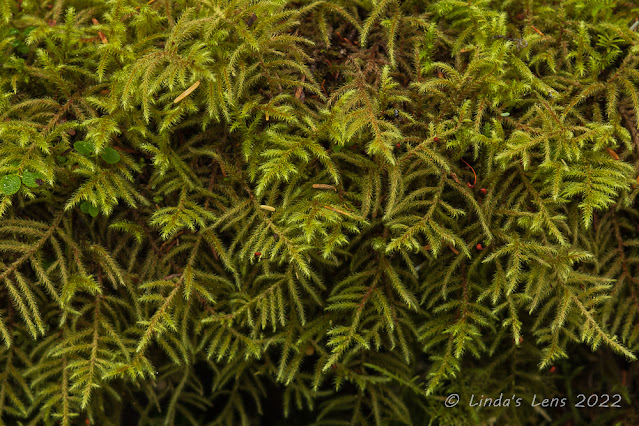 |
| Moss close-up |
Part of the trail was on a very nice wooden boardwalk. The boardwalk took us past a series of small ponds, the largest full of lily pads.
 |
| Not many wildflowers, but I did find this tiny purple one |
After a pleasant one-mile walk, the Forest Trail dumped us out on the rocky coastline of Bartlett Cove. We could either follow the coast trail back to the lodge, explore the beach, or duck back into the woods and check out the campground. Since the tide was out, Hubby and I first decided to see if there were any tidepools on the beach.
 |
| The rocky beach at low tide |
Sadly, no tidepools were found. The beach was littered with rocks. We noticed one rock was covered with deep grooves, likely scraped by long-ago glacial activity. One interesting fact we discovered - with the retreat of the glaciers, the land that was once covered by the weight of several feet of ice is now rising. This upsurge has added more land area to the properties bordering Glacier Bay.
A bit of moss grew between the rocks normally covered by high tide, so some of them were quite slippery. And the closer you got to the water the more sticky mud one encountered. Ugh, this wasn't any fun. Time to turn around and check out the campground!
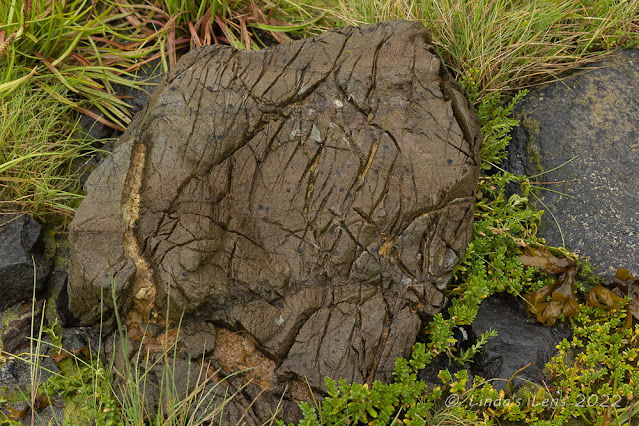 |
| The scrapes on this rock may be due to glacial action |
Like nearly all U.S. National parks, Glacier Bay provided a large campground for people who enjoy a bit more rustic accommodations. Since most visitors either arrive via plane or boat, the campground didn't provide much vehicle parking. So this campground was a series of trails through the mossy understory with side paths to specific numbered sites. If you chose a site at the very end, it would be a long walk carrying all your camping gear.
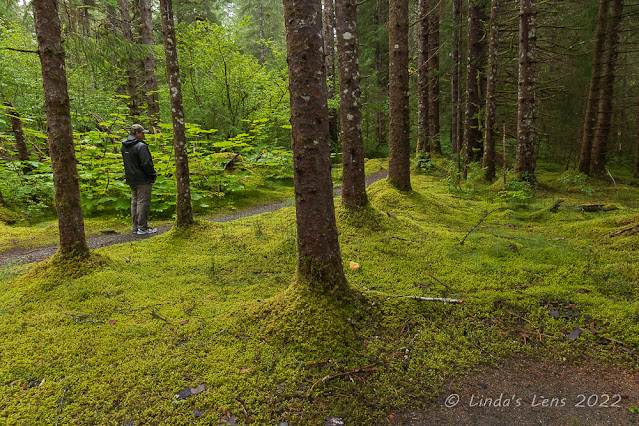 |
| Walking through the campground |
The other difference at this campground - since there were many bears in the nearby forest, no food storage was allowed at your campsite. Instead a sturdy wooden building was provided for this very purpose.
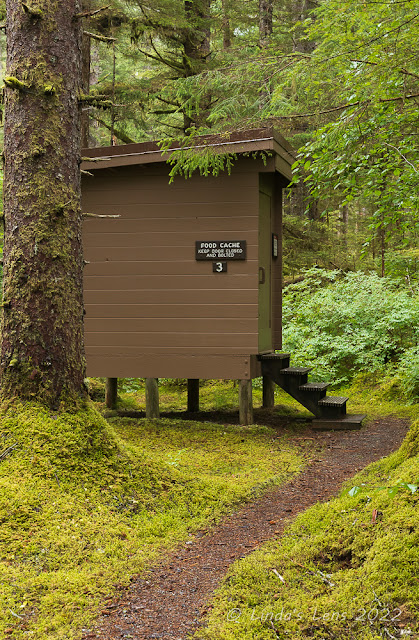 |
| No storing food at your camp! |
With the drippy weather, we saw exactly two tents in the campground out of about 30-some campsites. Not very many folks were taking advantage of staying here, even though it was free. (Not that I blame them, having done it many times I think camping in the rain is a miserable experience.)
 |
| This path was lined with large bushes of Devils club |
After reaching the end of the campground, Hubby and I retraced our steps back through the wet, mossy forest. One path was lined with huge bushes of Devils club, which required a bit of maneuvering to avoid their thorny branches.
 |
| Raindrop-jeweled asters |
Emerging out of the forest onto the coast path once again, Hubby and I followed it back towards the lodge. I noticed a small patch of waterlogged asters, their petals bejeweled with raindrops. We also spied a totem-like figure carved into one of the nearby tree trunks.
 |
| Someone had carved a totem into this tree |
We still had an hour before our shuttle driver was due to pick us up so I decided to drop in to the ranger station and inquire about hiking another nearby trail that followed the Bartlett River. When I asked the ranger behind the desk about this trail, his first question was "Do you have bear spray?" When I replied that we didn't, the ranger proceeded to warn me about a mother bear that had bluff charged a woman on the same trail the previous day. However, the ranger advised me that as long as I made noise as I hiked, we'd probably be okay. He explained this gives the bear warning that people are coming, so they can avoid you. The worst thing a person can do is surprise a bear.
 |
| Misty day at the Huna Tribal House |
When I told Hubby about the bear situation, he was all for hiking the trail. He kind of hoped we'd see a bear. However, I wasn't so sure about that. I was afraid we'd surprise one and that was the last thing I wanted. However we decided to head off towards the Bartlett River trail anyway, bear or not.
 |
| These totem poles were very tall! |
Our path to the Bartlett River trail led us past the Huna Tribal House and I had fun showing Hubby the beautifully decorated building (that sadly wasn't open yet) and the two impressive totem poles standing guard.
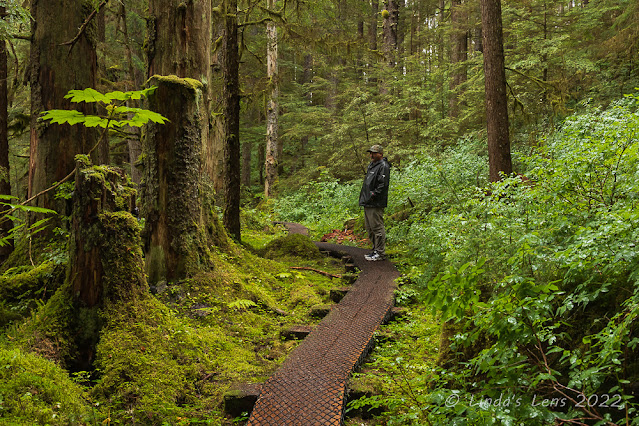 |
| Hiking on the Bartlett River Trail |
It was about a half mile walk to the trailhead. As we started out on the Bartlett River trail I was dismayed to see the forest was full of huge bushes, perfect for a bear to hide behind. Gulp! As Hubby walked ahead, I took up the rear, trying to keep up a conversation with him. But my hubby isn't much of a talker and he walks much faster than me. So when he got farther ahead I began calling out "Hey bear!" periodically. Let me tell you, yelling "hey bear" gets old fast. So I started yelling out other things, like "How's it going bear?" and "Don't eat us bear!" I know I annoyed the heck out of my hubby, but on the plus side we saw zero bears (or any wildlife) for the entire hike.
 |
| More "Bears Breath" fungi |
The Bartlett River Trail was a 1.7 mile rough path that paralleled the Bartlett River. But the forest was so thick here I only got one glimpse of the river through the trees. We'd hoped to hike the entire 1.7 miles, but after a mile of tromping through mud over rocks and tree roots, my plantar fasciitis was acting up big time. Looking at our watches, we also realized we needed to head back soon if we were to meet our ride in time. So Hubby and I turned around and retraced our steps back to the lodge. Good thing we did as we made it with about 15 minutes to spare.
 |
| It was a wet, muddy trek! |
Back at our lodge, we still had most of the afternoon to entertain ourselves. By now the rain had paused so I suggested to Hubby that we borrow some bikes and ride the short distance into town. Gustavus was so small it only had one gas station. The pumps looked like something from the 1950's. Perfect photo subjects!
 |
| The only gas station in Gustavus |
Although it was only about a mile into the "hub" of Gustavus, nearly half of our route was on a bumpy, potholed gravel road. Made pedaling our well-worn loaner bikes a bit of a challenge. But once we hit the paved main road it was smooth sailing to the gas station.
 |
| I loved these old pumps |
The gas station was like opening a time capsule from a bygone era, from the ancient pumps to the old Mobilgas sign. There were three pumps - one for gasoline, one for diesel fuel, and one for stove oil. Gas was a whopping $5.89 a gallon and diesel $6.99 a gallon! Inside the station were more antiques mostly related to filling stations of old.
 |
| "Downtown" Gustavus |
Diagonally across the road was a dilapidated strip mall housing a few businesses. The gas station and this building were all there was to "downtown" Gustavus. Having taken a good look at the "business district" Hubby and I turned our bikes around and headed back. Along the way, we passed by a very Alaskan traffic sign.
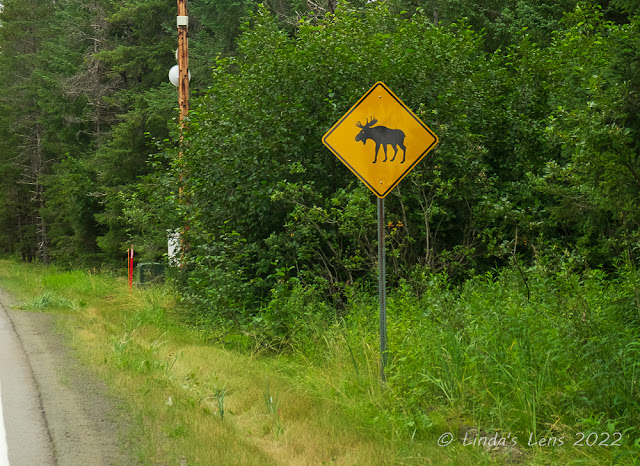 |
| Different road hazards in Alaska |
Our trip home was a series of flights from Gustavus, through Juneau, including an overnight stay in the Seattle airport (yes, we were "sleepless in Seattle.") But it was a wonderful trip. I checked another National Park off the list! Hope you've enjoyed all my recaps. If you've missed any, I've listed all the Alaska blog posts below:
Glacier Bay National Park by Boat
Critters of Glacier Bay National Park
Exploring Glacier Bay National Park









